This post is also available in:
Deutsch
Panettone is the Christmas dessert par excellence. It's a symbol of Christmas, of being with friends and enjoying a moment of pure culinary pleasure. It took me a lot of experimenting to create a vegan recipe as good as the traditional one. After lots and lots of failed attempts I'm happy to share with you the recipe to make a fluffy, soft and super flavorful vegan Panettone.
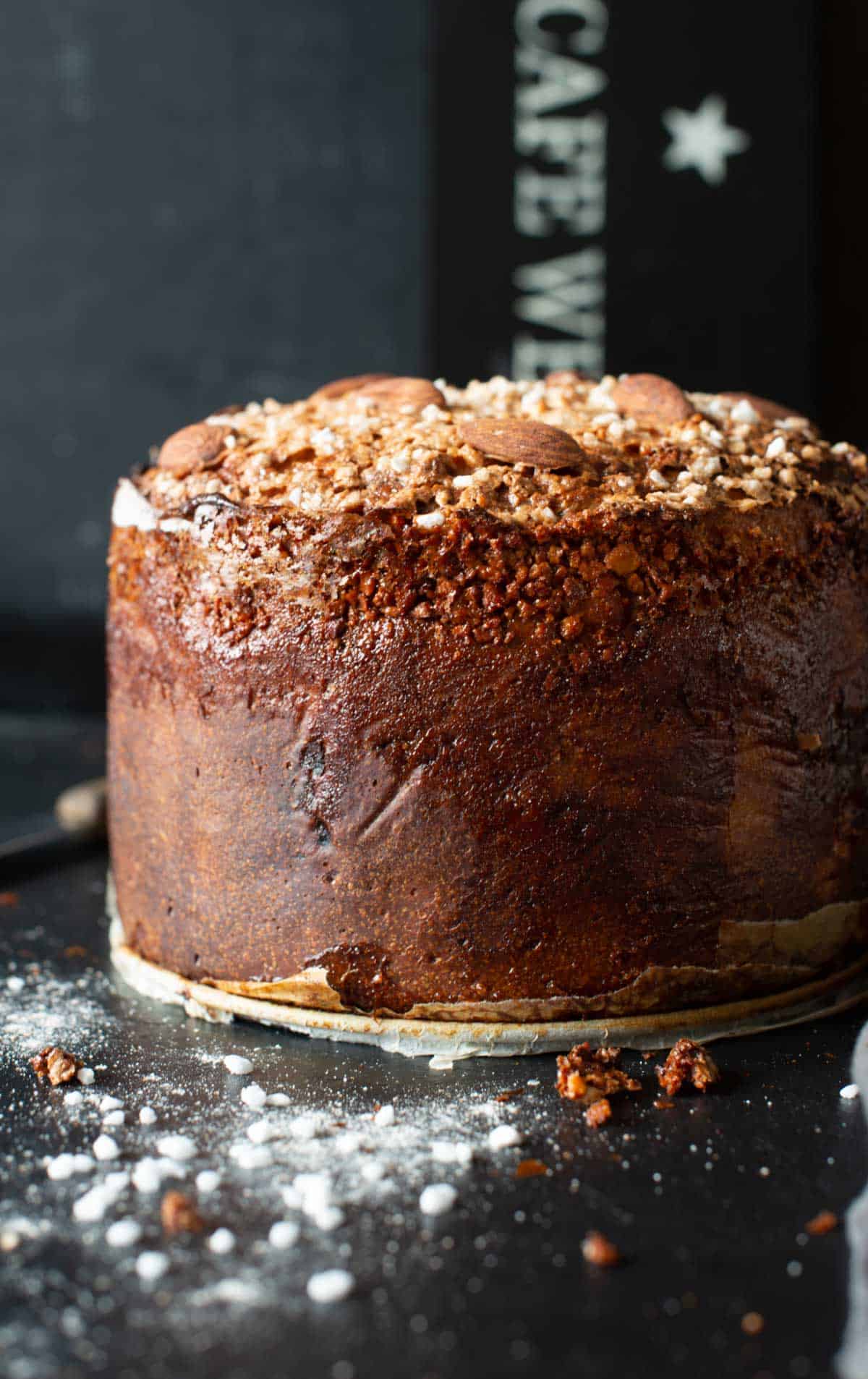
This vegan Panettone is super soft, full of flavor and absolutely perfect to enjoy with a cup of tea or a coffee.
This recipe is inspired by the following wonderful blogs that have also featured vegan panettone recipes: my personal trainer, giallo zafferano, avegtastefromatoz. Check them out if you need more inspiration.
Jump to:
- Premise
- Where did Panettone originate?
- Is Panettone vegan?
- Ingredients
- Sourdough or Brewer's Yeast?
- What kind of flour is used for Panettone?
- How to make strong flour (if you can't find it)
- What happens if I don't use strong white flour?
- Can Panettone be made gluten free?
- Kneading
- How to know if the gluten network is strong
- I don't have a kneading machine nor a food processor, what can I do?
- Food processor
- Almond glaze
- Candied fruits
- Time Management
- Rising time
- Mold
- How to bake
- Do I have to hang my Panettone upside down?
- How to store
- More Delicious Desserts
- 📖 Recipe
- 💬 Reviews

Premise
Making panettone is an art, it takes time, patience and you need to pay attention to some steps.
Before making the panettone I strongly recommend you to read carefully this blog post. I have tried to explain as best I can every difficult part of the recipe in order to help you avoid unnecessary mistakes.

Where did Panettone originate?
Let's dive into the beautiful world of Panettone. Shall we? Do you know where it comes from?
The answer is simple: Italy. More precisely, it was born in the Middle Ages and it is connected to the tradition, which was in force at that time, of preparing very rich breads for Christmas, which were served by the head of the family to the guests.

Is Panettone vegan?
Panettone is made using butter and eggs.
This means that traditional Panettone is vegetarian not vegan. That said, the vegan Panettone you'll make using this recipe is going to be just as delicious!

Ingredients
To make this vegan Panettone you will need 13 ingredients and between 1 and 2 days of time (depending on the room temperature).
I know it sounds like a lot of time but you will only need to actively work for about 45 minutes. The rest is just rising time.
These are the ingredients you'll need:
- strong bread flour with 15.5% protein, W 460 (in Italian we call it Manitoba flour, click here to check it out)
- cornstarch
- caster sugar
- soy milk
- vegan butter
- brewer's yeast
- organic oranges
- organic lemons
- vanilla powder
- candied oranges (optional)
- almonds (optional)
- aquafaba (optional)
- pearl sugar (optional)

Sourdough or Brewer's Yeast?
Traditionally Panettone is made using sourdough, but since few people have it at home and know how to use it, I preferred using brewer's yeast.
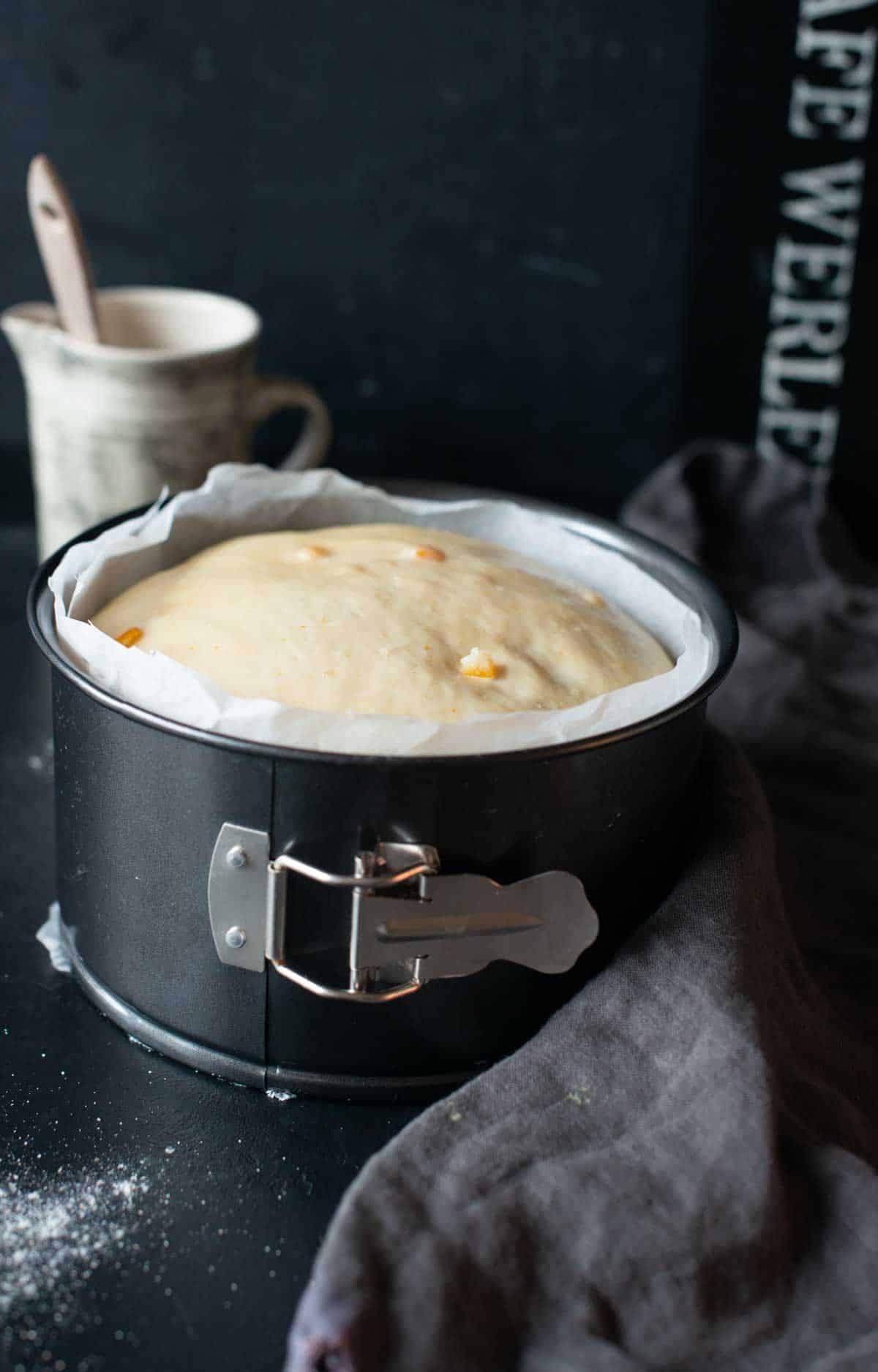
What kind of flour is used for Panettone?
Using the right flour for this recipe is essential. Panettone is a pastry rich in fats and with a substantial weight, therefore we must use a flour with 15.5% of proteins per 100g of flour.
In Italy this kind of flour is called Manitoba and it has a W value equal to 460. For those who don't know, The W value indicates the strength of the flour and therefore the quantity of proteins it contains per 100 g of product. A value of 460 is equivalent to 15.5 grams of protein per 100 grams of flour.
Why is it important to use a flour with so much protein? Because when we add water to a protein rich flour it causes the hydration of two types of proteins: gliadin (responsible for elasticity) and glutenin (responsible for stability and strength). The hydration of these two leads to the formation of what we call a gluten network.
The gluten network is able to do two important things: it helps the dough rise by trapping the gas bubbles formed during fermentation and it keeps the structure of the dough intact preventing the collapse of the dough once filled with air bubbles.
Because Panettone is rich in fats, the flour we use must be able to create a gluten network able to sustain the weight of the pastry without collapsing. That's why this recipe only works with a strong white flour.

How to make strong flour (if you can't find it)
This seccion is ONLY for those of you who can't find Manitoba flour anywhere! If you found it, go to the next part of this blog post (you lucky bean!).
Finding Manitoba flour or a flour with 15.5% of protein can be a struggle. After racking my brain for days on how to get it, it occurred to me that maybe I could make it myself. In fact, I had a package of vital wheat gluten powder in the kitchen just waiting to be used. So I basically fortified my flour by adding vital wheat gluten powder.
That's how it works (we need to do some math, sorry). For this recipe we need 400g of strong flour with 15.5% protein. The all purpose flour I use contains 11 g of protein per 100 g of product. So my flour is missing 4.5 g of protein per 100 g to be considered strong. So to have 400 g of strong flour I have to add 18 grams of protein.
The packet of vital wheat gluten powder I have has 75 g of protein per 100 g of product. So to add 18 grams of protein to my 400 g of flour, I have to add 22.5 g of vital wheat gluten powder. And that's how I fortified my flour!

What happens if I don't use strong white flour?
This:

The gluten network won't be strong enough to hold all the air bubbles, which will cause them to break and form a giant hole in your Panettone. Been there, done that 🙂
Can Panettone be made gluten free?
I've never done it gluten free. Yet I found this recipe and it looks very promising!
My recipe can definitely not be made gluten free though (for now), sorry.
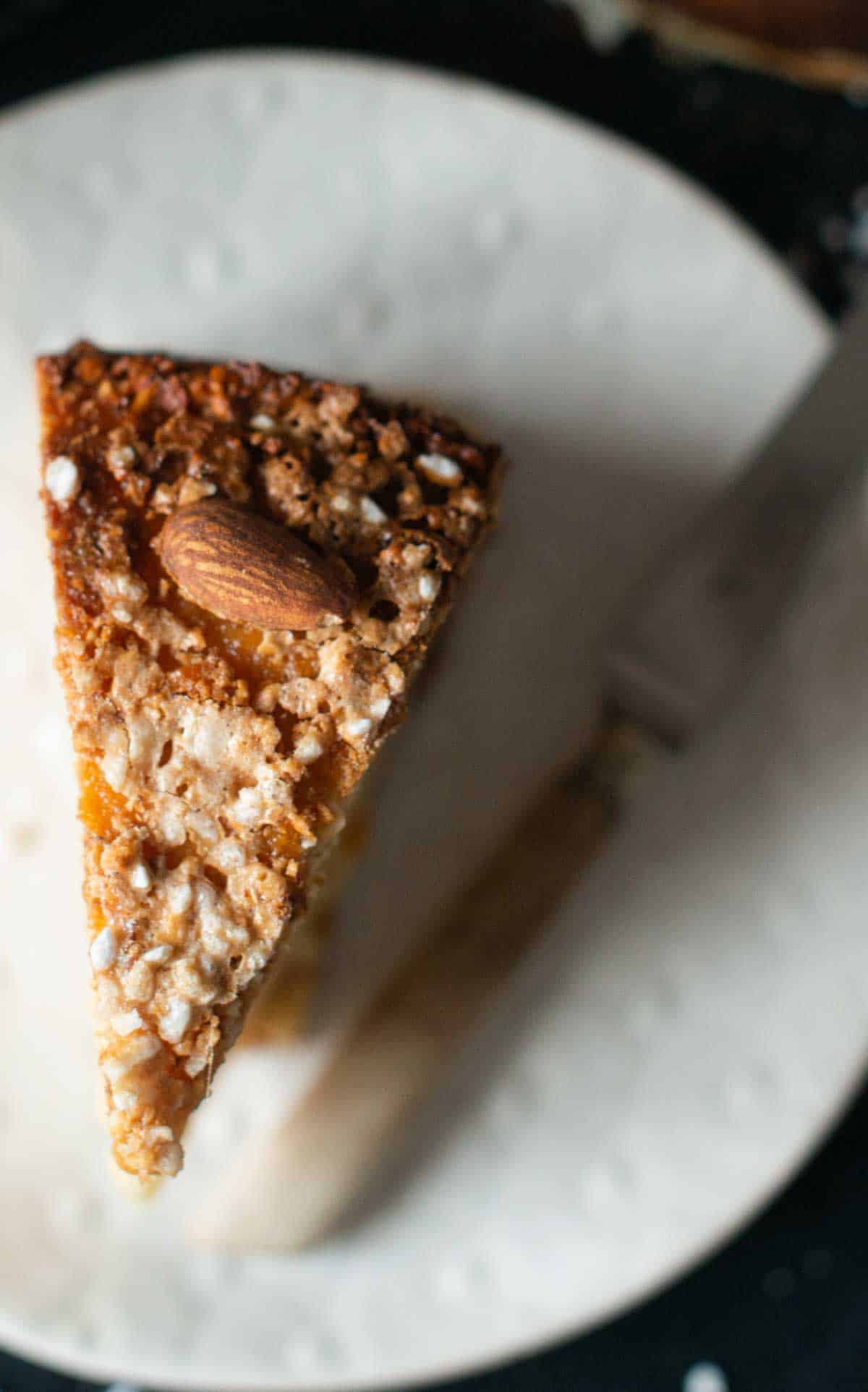
Kneading
A strong gluten network is the key for success when it comes to Panettone. But how do we form it? Simple, by kneading the dough. Kneading causes the gluten strands to become stronger and longer, which basically means: the more the dough is kneaded, the stronger the gluten network becomes.
Unfortunately, this process cannot be done by hand. I've tried several times and have never been able to create a dough with enough strength. They all collapsed in the oven.
This unfortunately means that you can only make Panettone if you use a food processor or a kneading machine to mix the dough.
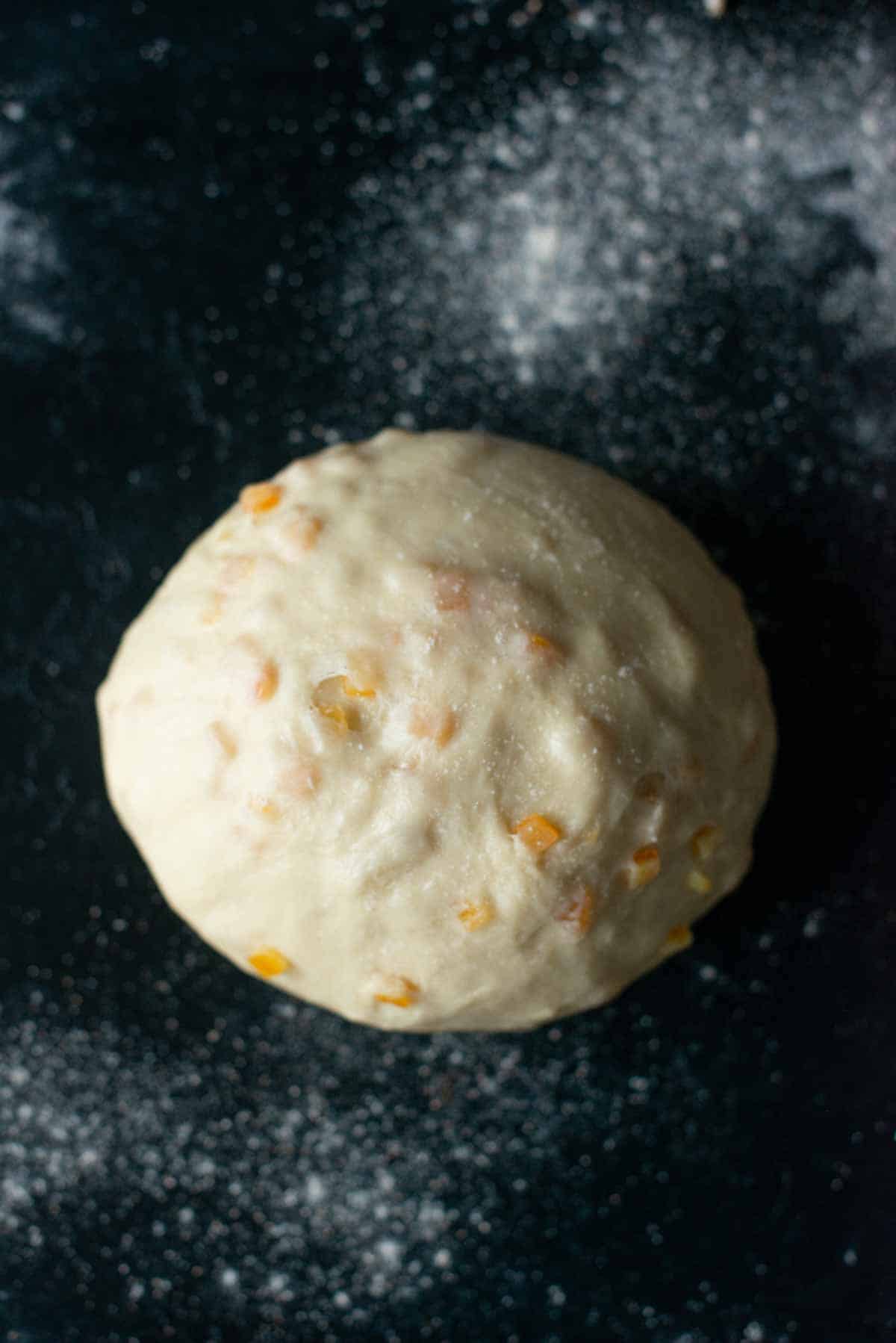
How to know if the gluten network is strong
To know when the gluten network of our dough is strong, we have to knead our dough -with a food processor or kneading machine- until it starts building strings (like the ones you see in the two pictures below).
In Italian we say "the dough si è incordato (eng. "it has built strings") when this happens. Also the dough will be super elastic and almost unbreakable. By pulling a portion of the dough with your fingers it should form a thin almost transparent veil.
If it breaks while doing so you have to keep on kneading.

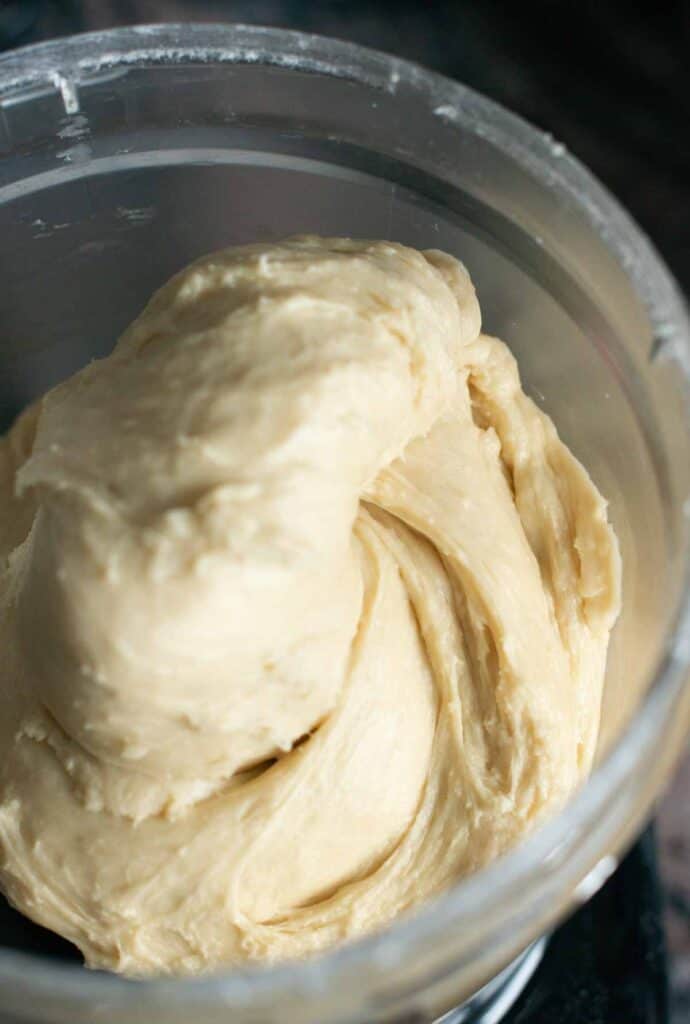
I don't have a kneading machine nor a food processor, what can I do?
If you don't have either of them you can make mini Panettoni. In this case, the dough will not need to be particularly strong because the panettoni will be small sized.
That's how you do it: Once the dough is done, instead of letting it rise in the panettone mold, divide it into about 15 ping pong ball sized balls. Add about 15 ramekins to a muffin mold and place a ball of dough in each ramekin. Cover with film and let them rise until they have doubled in size. Brush them with almond glaze and bake them in the oven at 180 °C (360 °F) for 15-20 minutes. They will be delicious!
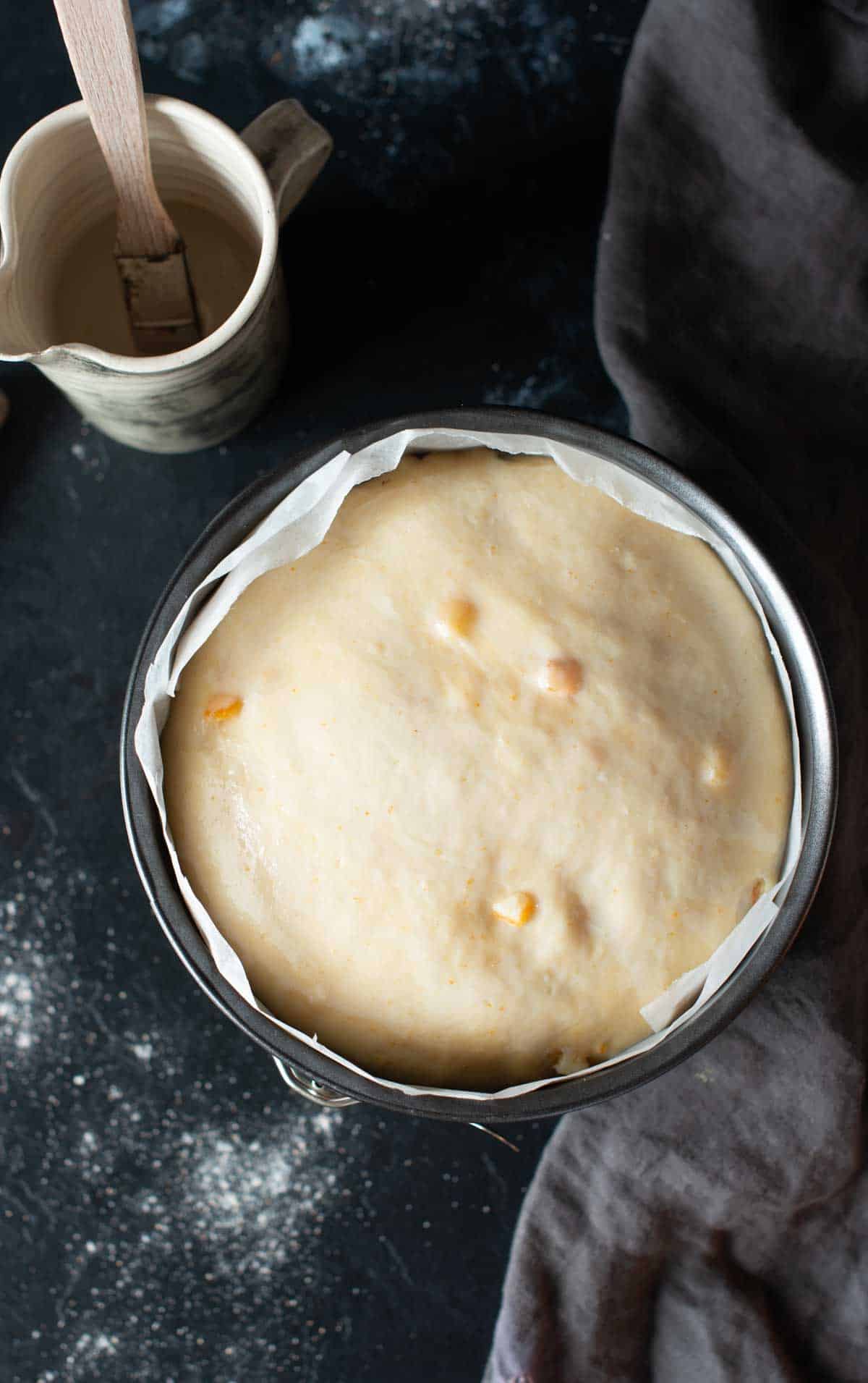
Food processor
Using a food processor is the quickest way to make a Panettone. In fact, in just a few minutes it's able to make an elastic and smooth dough with a strong gluten network. The only problem is that, unlike a kneading machine, it tends to heat up the dough.
The bacteria in the brewer's yeast (responsible for the rise of the Panettone) die once the environment reaches 38°C. The death of the yeast is the death of your Panettone. Long story short: you really want the bacteria to stay perfectly healthy. So do not overheat the dough. If you notice that while you knead it, it gets warm, let it cool on the balcony for a few minutes or place it on a cold surface.
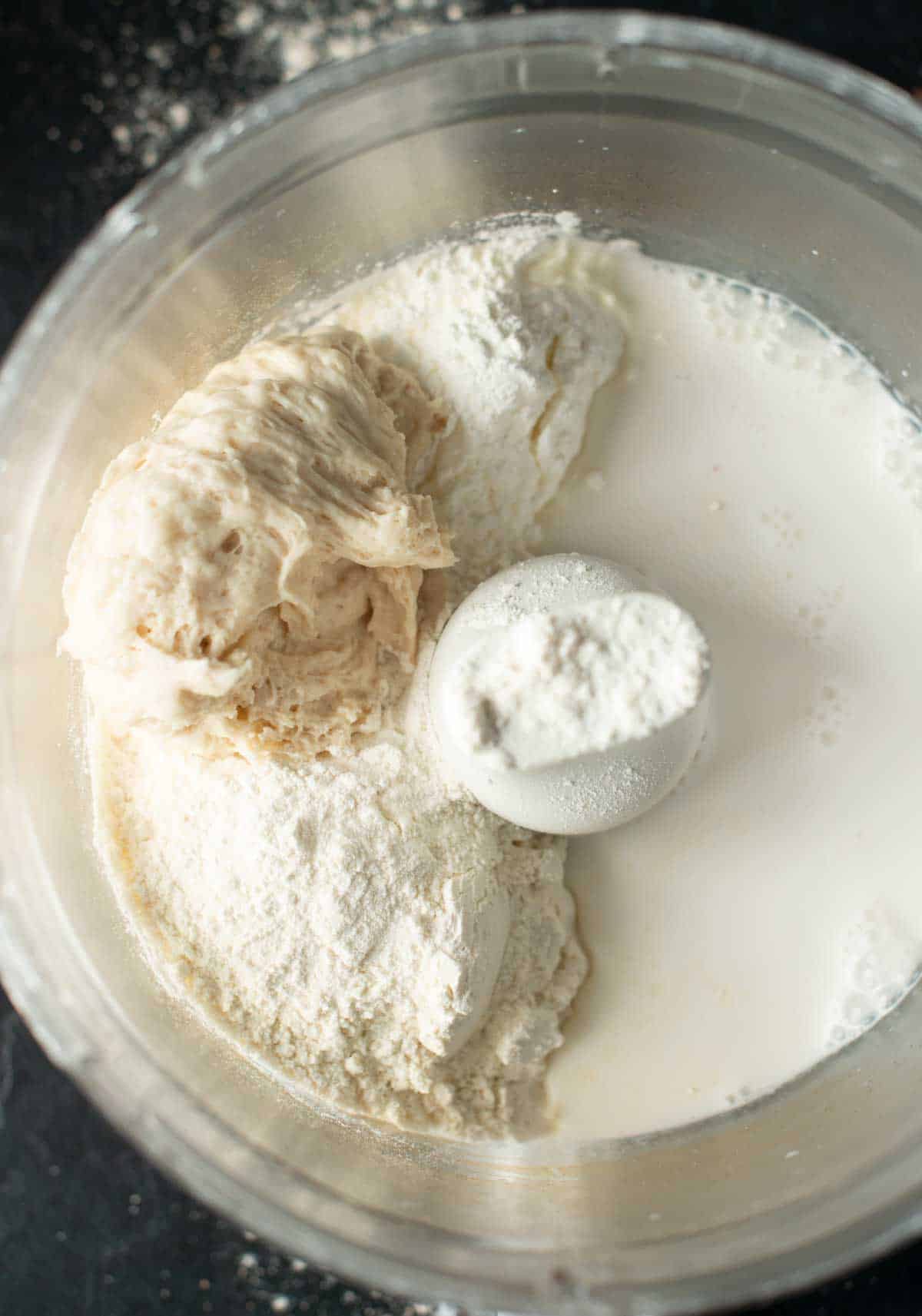
Almond glaze
When it comes to Panettone there is one glaze that I absolutely love: almond glaze.
Made with only 4 ingredients: almonds, sugar, aquafaba and pearl sugar. This glaze is crunchy, perfectly sweet and it tastes like roasted almonds! It's absolutely mindblowingly perfect! Don't skip it! You'll thank me later!
If you want the replace the almonds you can use hazelnuts or pecans.

Candied fruits
Candied fruits are either loved or hated. I'm crazy about candied oranges so I add them.
If you don't like them, however, you can omit them or replace them with dark chocolate chips.
Some people also add rehydrated raisins (I don't). If you want to add them just soak them for 30 minutes in hot water, squeeze them well and add them to the dough together with the candied oranges.

Time Management
Making this delicious vegan Panettone takes about 2 days to prepare (depending on the room temperature). In my flat I allow the dough to rise at about 21 °C, next to a radiator and this is the timeline that works for me:
- Day 1 / 8:00 am: make the first dough.
- Day 1 / 9:30 am: make the second dough
- Day 1 /14:30 pm: make the third dough
- Day 2 / between 14:30 pm and 20:00 pm: baking
If you can allow the dough rise in an oven with the light on at about 25 °C - 26 °C the following timeline should work for you:
- Day 1 / 8:00 am: make the first dough
- Day 1 / 9:30 am: make the second dough
- Day 1 / 13:30 pm: make the third dough
- Day 1 / 18:30-19:30: baking
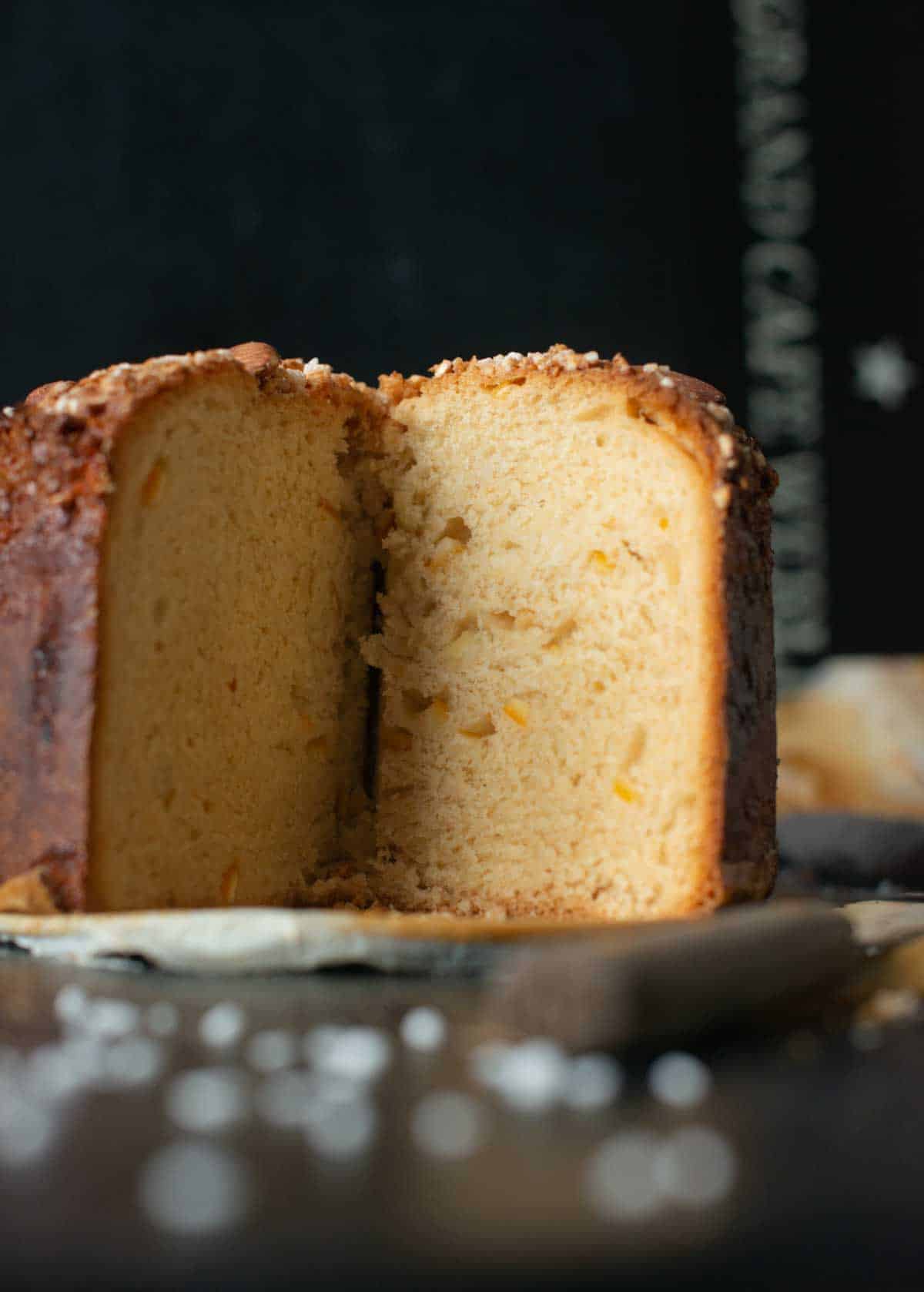
Rising time
The rising time for each dough changes drastically depending on the room temperature and how active the yeast is. So take the rising time in the recipe with a grain of salt, it's more important to orient yourself to the growth of the dough than to the time spent.
I always take a picture at the beginning of each rise so I can tell how much it has risen. If you have an oven with a light, remember that you can let the panettone rise in the oven turned off with the light on. In this case you will always have a constant temperature.
The rising time indicated in the recipe are those more or less needed to let the panettone rise at 21 °C near a radiator.
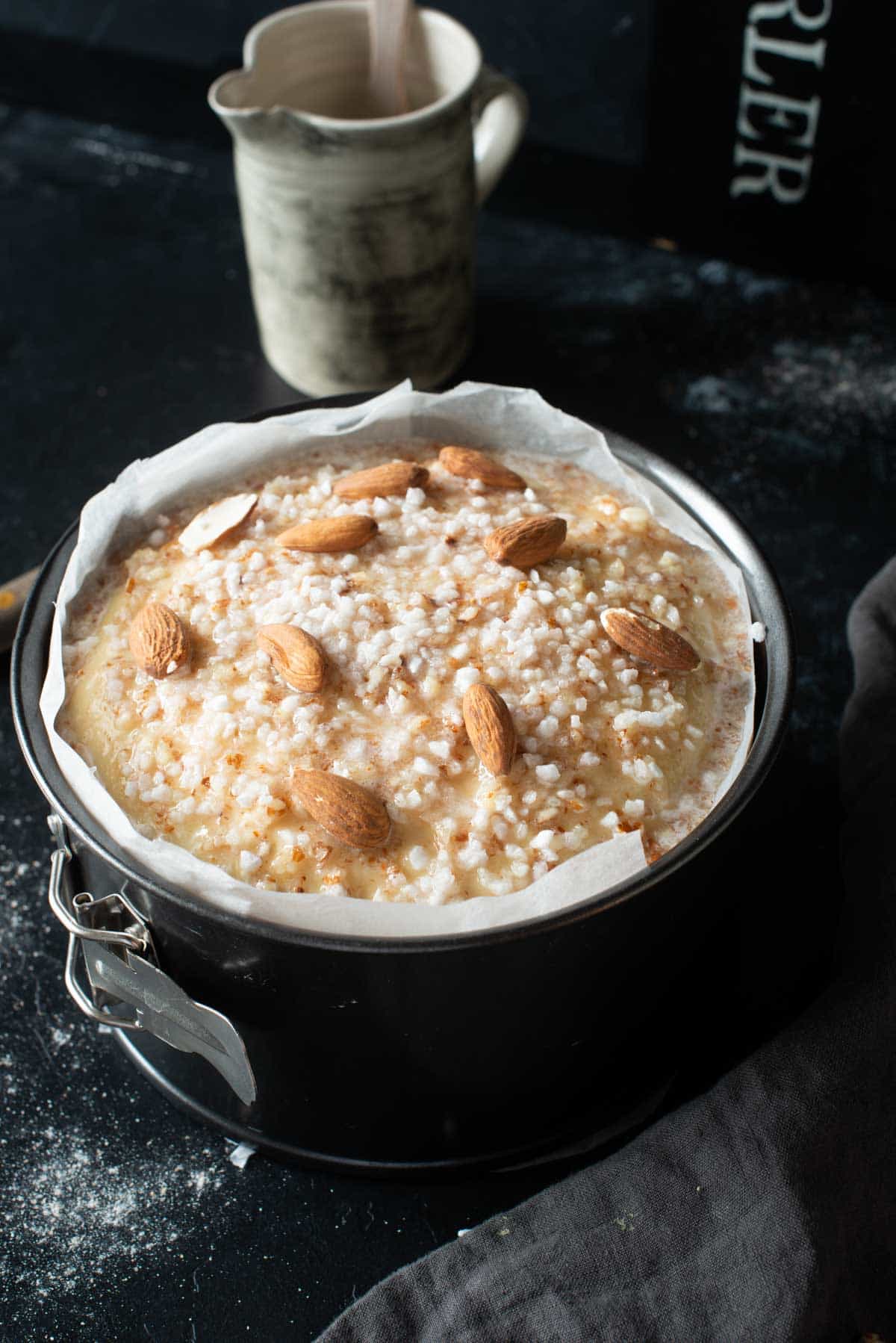
Mold
I recommend using a 10 cm (4 inches) high Panettone mold with the diameter of 18 cm (7 inches).
If you don't have one, you can make one. There are lots of tutorials online. I never tried making one but I'm sure they'll do the job. Here is a cool tutorial I found: How do I make Panettone paper molds.

How to bake
Let's start with the premise that every oven is slightly different. In my oven, I bake the Panettone at 180 °C (360 °F) for 60 minutes in the lowest rack of the oven.
After the first 15 minutes I cover the top with foil to prevent it from burning. The Panettone is perfectly baked when the center reaches 95 °C (200 °F) (I've never had to check the temperature of the center tbh).
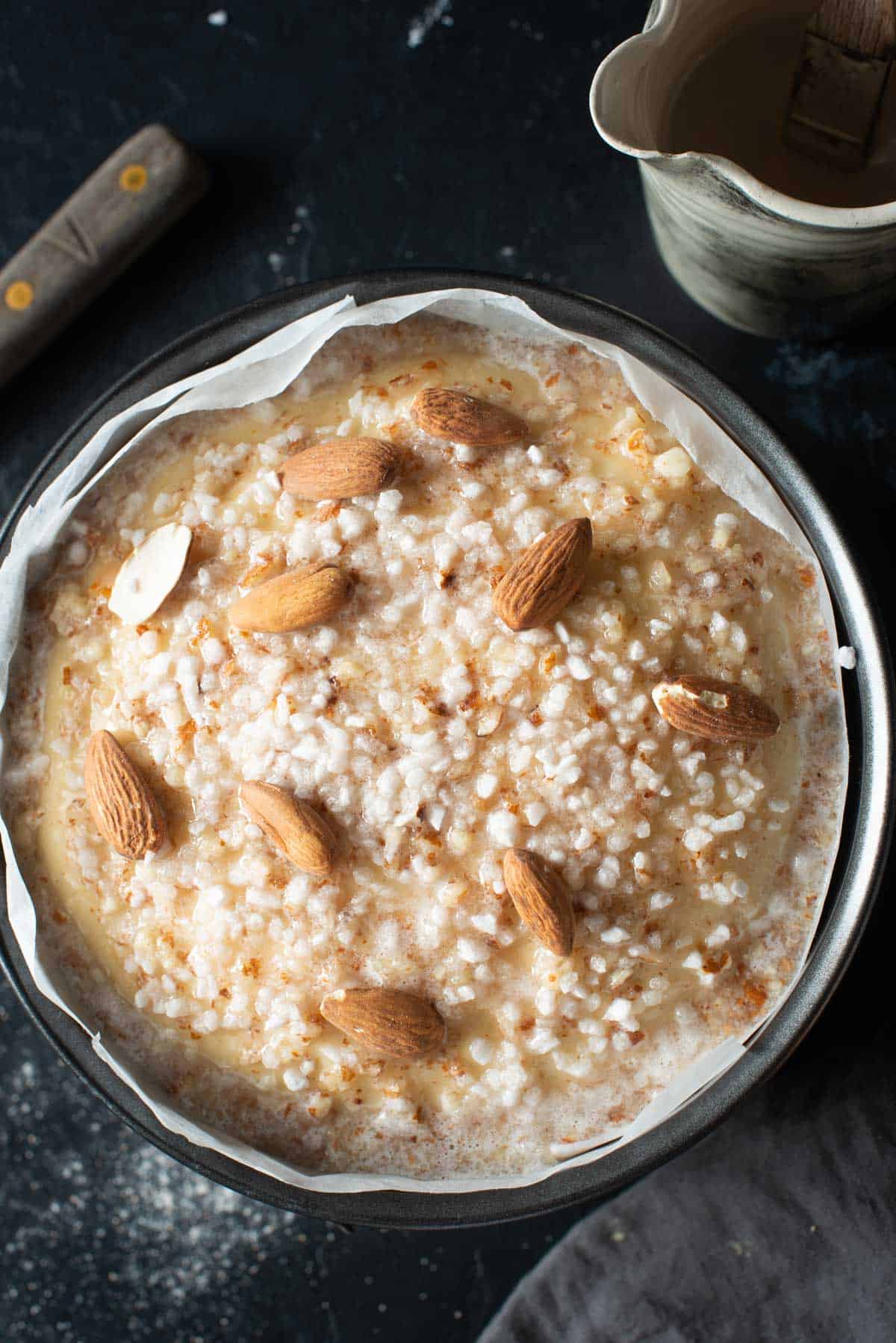
Do I have to hang my Panettone upside down?
Traditional Panettone is flipped upside down once baked until it cools. This prevent it from collapsing. I've never done it with this recipe and the result is amazing. So you can skip this part.
How to store
Panettone should be wrapped in plastic wrap and placed in a zip-close bag. It can be kept at room temperature for up 5-7 days. For longer storage, wrap tightly in film and freeze. Defrost it in the refrigerator before toasting it the oven (160 °C, 320 °F) for 5 minutes.

More Delicious Desserts
- Italian Custart Tart (Torta della Nonna)
- Super Creamy Vegan Pumpkin Cheesecake
- Extra Fudgy Vegan Butter Beans Brownies
If you have Pinterest, feel free to pin the following picture and to follow me by clicking here 😌
📖 Recipe

Vegan Panettone Recipe (with brewer’s yeast)
Equipment
- a 10 cm (4 inches) high panettone mold with the diameter of 18 cm (7 inches)
- kneading machine or food processor
Ingredients
Total Ingredients for 1 kg mold
- *400 g strong flour ((14 oz))
- 50 cornstarch ((2 oz)
- 15 g brewer’s yeast ((½ oz))
- **220 g soy milk ((7¾ oz))
- 180 g sugar ((6½ oz))
- 100 g vegan butter ((3½ oz))
- ***100 g candied oranges optional ((3½ oz))
- 1 teaspoon vanilla powder
- ****2 organic lemons zested
- ****2 organic oranges zested
- ½ teaspoon salt
Almond Glaze
- 25 g almonds optional ((1 oz))
- 50 g sugar optional ((1¾ oz))
- 40 g aquafaba optional (( 1½ oz))
-------
First dough
- 35 g lukewarm water ((1 oz))
- 1 teaspoon sugar
- 15 g brewer’s yeast ((½ oz))
- 50 g strong flour ((1¾ oz))
Second dough
- 1st dough
- 160 g strong flour ((5½ oz))
- 160 soy milk ((5½ oz))
- 50 g cornstarch ((1¾ oz))
- 30 g sugar ((1 oz))
- 50 g vegan butter room tempered ((1¾ oz))
Third dough
- 2nd dough
- 190 g strong flour ((6½ oz))
- 165 g sugar ((6 oz))
- ½ teaspoon salt
- 50 g soy milk ((1¾ oz))
- 50 g vegan butter room tempered ((1¾ oz))
- 1 teaspoon vanilla powder
- zest of 2 lemons
- zest of 2 oranges
- 100 g candied oranges ((3½ oz))
Instructions
First dough
- For the first dough, add water, sugar and yeast to a bowl and mix until dissolved. Add flour and knead briefly. Form a ball, cover it with film and let it rise until it triples its size (1 hour).
Second dough
- For the second dough. Add the first dough to the bowl of the planetary mixer or food processor along with flour, sugar, starch and vegetable milk. If you use a planetary mixer knead the dough with the flat beater for about 10 minutes. If you use a food processor knead the ingredients for about 60 seconds until you get a smooth and elastic dough (do NOT overheat the dough or you will kill the yeast, if the dough gets warm allow if to cool briefly and then keep on kneading!).
- Once the dough is smooth and elastic, add the vegan butter and knead until incorporated. The dough is ready when it starts building strings while kneading. when this happens the dough should look like the picture below.
- Set the dough into a large bowl, cover it with film and allow it to rise until quadrupled in size (4 to 5 hours).
Third dough
- For the third dough, put the dough back in the planetary mixer, add the flour, vegetable milk and sugar and knead well for a few minutes. If you use a food processor, add the ingredients and knead for 30 seconds.
- Add the sugar, lemon zest, orange zest and vanilla and continue to mix for another 3-5 minutes. If you use a food processor add the ingredients and knead for 15 seconds.
- Add the butter a little at a time until fully incorporated.
- Replace the flat beater with the dough hook (if you use a kneading machine) and knead the dough until it reaches a strong gluten network (pulling a portion of the dough with your hands should not break but form a thin almost transparent veil.
- Remove the dough from the bowl of the planetary mixer or food processor and place it on a working surface. Form a large circle, lay the candied oranges on top and fold the dough over. Knead by hand for 1-2 minutes until evenly distributed.
Final rising
- Roll the dough to form a ball. Transfer it into the panettone mold lined with baking paper and cover with film. Allow the dough to rise until it has quadrupled in volume and it has reached the top of the mold. The dough is ready once about 1 cm of the top of the dough is out of the mold. This step will take between 5 and 24 hours depending on the room temperature. Brush the top of the dough with water every now and then if you see that it dries.
Glazing and baking
- Once the dough has reached the top of the mold, start preheating the oven to 180° C (350° F).
- For the glaze, place almonds, sugar and aquafaba in a food processor and blend until ground (it doesn't have to be smooth). Brush the glaze on top of the panettone, top with more almonds and a handful of pearl sugar.
- Bake the vegan panettone for 1 hour, or until the internal temperature reaches 95° C (95° F) (measured with a kitchen thermometer). After 15 minutes cover the top of the panettone with foil to prevent it from burning.
- Once baked allow it to cool for 2-3 hours. Serve immediately or store in a zip-close bag for up to a week.

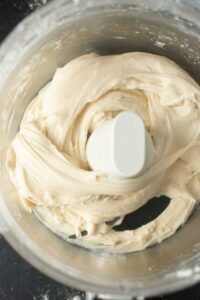
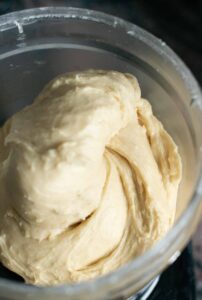
Scott Lewis says
Not sure where I've gone wrong trying to make the first dough. I've quadrupled checked all the measured amounts of ingredients for the first dough, but it's only ended up as a hard, dense, dry ball that hasn't risen at all after one hour. It seems to me it's simply too dry and needs more liquid (warm water). Hope I can figure out my mistake. Thank you.
G says
This happened to me when because the brewer's yeast I bought online was dead. I substituted it for active dry yeast, and it came out perfect
Lumila Orieta says
Great recipie, the taste is delicious, I replaced the half of sugar for monk fruit, added 2 oz of Jamaican rum and and put inside pecan and chocolate chips. I recommended 100%!!! Thanks for the recipe!
Asteiris says
Thank you for the recipe, it was great to have something with nice simple ingredients to work with. It looks and smells insanely good. I think my kitchen was a little too cold, it stopped growing on the third rise between 12 and 24 hours, but I got a little worried that would be over-proofed so started baking it anyway, I think that might have been a mistake. The glaze unfortunately seemed to make the centre soggy, it was still coming out wet event after the full baking time. This might be because it didn't rise enough and get that nice rounded tope that it make the glaze pool at the size not in the centre. I put it in for another half hour and it's still wet, which I'm a little bummed about as it was going so well! I might experiment with the glaze next time.
gralion torile says
We're a group of volunteers and opening a new scheme in our community. Your site offered us with valuable info to work on. You have done a formidable job and our entire community will be grateful to you.
G. D. says
Love your Pannetone recipe, and I’m getting better at making it. (I’m a great cook but a lousy baker! 😂)
Just wanted to correct your history info a tiny bit…
Although people associate this bread with Italy, if it was first made in the Middle Ages, you would have to then assume it was a ROMAN recipe, not an Italian one, as Italy has only been a country since 1861 (yes, she’s actually younger than the United States! -Freaky, right?) I am a first generation Italian-American (although my Dad came here when he was a small boy) so I’d LOVE to claim that Italy has been a country since the 1500’s, but it just wouldn’t be accurate or fair to all the peoples who helped make Italy what it is today. (minus the covid! 😉)
Anyway, I hope that info left you wondering more about its amazing history and especially makes you want to keep making wonderful Italian (or Roman😜) recipes!
-Bon appétit!
carlocao says
Dear G, thank you for sharing your knowledge! You're definitely right (I've never been too good at history xD), I'll update the blogpost asap 🙂 xCarlo
Esther says
I made this today and it’s wonderful! I started it pretty late yesterday afternoon so I put the second dough in the fridge overnight and resumed in the morning. The dough turned out beautifully, and the crunchy topping is perfect! Thank you so much for this recipe, I can’t wait to make it again!
G gal says
Besides the math being 30g of vital wheat gluten per 500g of flour (not 22.5g in 500g of flour if it’s only 75g protein per 100g. That 22.5g would be if you were mixing it in 400g of flour), I noticed you also said that in the photo, the flour was on the left and the vital wheat gluten was on the right. I don’t know if you’re seeing it the same as I am, but the flour is definitely on the RIGHT side in that photo.
I don’t know if my other comment got sent (it seemed to simply disappear) but I wanted make sure you knew how excited I am to make this! I hope I can do it some justice! 😁
carlocao says
Dear G, thank you for your message! I updated the text and corrected the mistake. The amount of strong flour needed is 400g (not 500g). So to have 400 g of strong flour we need to add 22.5 g of vital wheat gluten (if you use the same I mentioned in the blog post). I hope everything is clear now 🙂 let me know how it turns out! Best Carlo
G gal says
Hi, I am about to make this panettone and I noticed what I believe is an error. (Please explain if this is not wrong, because I guess I just don’t understand it then!🤪)
So, I understand that the 500g of flour is because you’re mixing the vital wheat gluten into a standard 1 pound bag of flour sold at most stores (I’m in the USA, but I am accustomed to using grams with my scale, so no worries!), That makes sense, but your math involving the vital wheat gluten did not.
I was going right along with you when you said that for 400g of flour, you needed 18g of protein, and for 500g you needed 22.5.
I was even on board when you said your vital wheat gluten is 75g of protein per 100g of it (making it 75% protein).
BUT… then you said you only needed 22.5g of vital wheat gluten per 500g of flour… which just does not figure.
If the vital wheat gluten’s protein is only 75%, you’d need 30g of vital wheat gluten to equal 22.5g of protein.
So, for 500g of flour, you would need to add 30g of vital wheat gluten, and then only use 400g of that mix for the panettone recipe.
Am I not correct?
Despite the confusion, I am excited to make this recipe and see how it turns out. I was raised on fairly traditional Italian food (my father was born in Italy, as were many of my other relatives) and have missed enjoying many foods since becoming vegan. Hopefully I can make one that’s at least half as lovely as yours looks!
carlocao says
Dear G, thank you for your message! I updated the text and corrected the mistake. The amount of strong flour needed is 400g (not 500g). So to have 400 g of strong flour we need to add 22.5 g of vital wheat gluten (if you use the same I mentioned in the blog post). I hope everything is clear now 🙂 let me know how it turns out! Best Carlo
Lisa says
I made this!! It looks and smells incredible but we are going to save it for Christmas morning.
I fortified my flour with gluten and substituted 7 grams of active dry yeast for brewers (I actually have a healthy sourdough starter but didn't want to deviate too far from your recipe). I also replaced some of the candied oranges with rehydrated raisins and cherries. I baked it in an oven-safe saucepan lined with parchment paper as per the recipe and it worked just fine.
I thought it was a failure on the final rise because the dough was really dense and firm but at the 24 hour mark it was perfect. I'm so curious to see how it looks on the inside.
carlocao says
Hi Lisa, the third rising of the panettone can take even more than 24 hours depending on your room temperature, so that's normal :). I'm so happy that it looks and smells delish! Once you try it, please let me know how it tastes 🙂 Best, Carlo
Lisa says
The panettone is just lovely inside and it tastes wonderful! I'll be making this every year. Thank you so much for the recipe!
carlocao says
Dear Lisa, I'm so glad you liked the panettone! Hugs, Carlo
Lisa says
This was so delicious and so satisfying to make that I made another one. I'll be investing in a proper panettone pan because I'll be making this at least once per year. Also, I don't know why my last comment is four stars because it should definitely be five. I would change it if I could.
Julia says
So excited to try this recipe! I'm a little confused on how to fortify the flour. Do I use all 500g of flour plus 28g of vital wheat gluten, or subtract 28g of the fortified flour after mixing? Thanks for sharing this 🙂
Carlo says
Hi Julia, thank you for your message. You are right, it’s not really clear. You have to use 500 g of flour plus the gluten you’ll add to reach the correct amount of protein in it. I hope it’s clear now 🙂 hugs, Carlo
carlocao says
Hi Julia, just to be sure, the recipe calls for 400 g flour not 500 🙂
Grazielle says
Hi
I wanna try this recipe. I don’t have brewer yeast 🥺 but I have sourdough.
What quantity do you think I should use?
Thank you so much 🙏🏽
carlocao says
Hi Grazielle, I'd replace the first dough with a SD levain. Try with 115 g SD levain: 15 grams sourdough, 50 g flour, 50 g water. I'd make the levain the night before you start making the Panettone. Let it rise overnight (about 8 hours). But be aware, this is just an idea, I cannot guarantee it will work. Let me know how it turns out. Best, Carlo